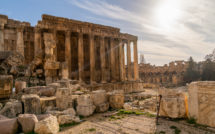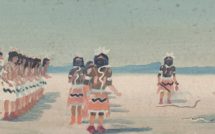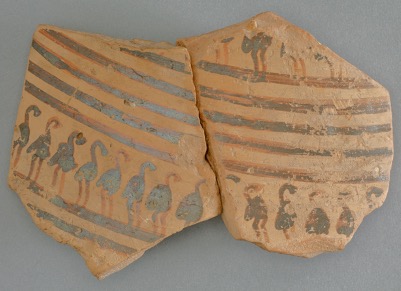
This is part of our Campus Spotlight on Columbia University and the Université Paris 1, Panthéon-Sorbonne.
In the storerooms beneath Columbia University’s Avery Architectural and Fine Arts Library, some 650 Greek pottery fragments dating from the Early Bronze Age to the Classical Period are sorted into individually labeled bags in sturdy trays. They have been studied sporadically over the past fifty years but are today largely unknown to students at the school. This group of sherds together constitute the Young Collection, named after Columbia alumnus and Professor Clarence Hoffman Young (1866–1957). Unlike comparable collections managed by Columbia’s Art Properties, there is no documentation explaining how the collection came into existence. The school’s archives are entirely silent about the fragments. There is no record of their acquisition and no documentation of their transfer to Art Properties, leaving those who attempt to study this material with limited resources. As part of the Parallel Heritages project, the Young Collection and its mysterious origins have again resurfaced.[1]
Given the obscurity of its formation, the Young Collection is an interesting but perplexing candidate for provenance research. The variation in the fragments’ dates and types makes them difficult to catalog, though strong efforts have been made recently.[2] In order to identify the provenance of at least some parts of the collection, the present study focused on twenty fragments of the same type. The style of the painted decoration on these pieces makes clear that they were manufactured in Argos in the late eighth century B.C. While the exact circumstances of their arrival at Columbia University remain unknown, this investigation has revealed a great deal about their origins. The Argive fragments at Columbia are not an isolated group, but they are in fact just a few of many pieces that trickled out of a major excavation at the end of the 19th century under the aegis of its field director, who distributed the finds widely amongst his colleagues. This circulation of Argive fragments is part of a broader phenomenon during the late nineteenth and early twentieth centuries, in which American universities built archaeological study collections to train their students for fieldwork. Issues of patrimony and cultural heritage largely put an end to this kind of collecting after the Second World War. The Argive collection at Columbia is thus not only a relic of antiquity, but also a vestige of past methods of teaching and collecting.
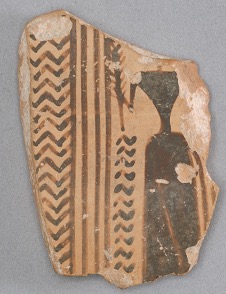
Fig. 1., Fragment of a large vessel attributed to the Dance Painter, Argive Late Geometric II (late eighth century B.C.E.). Art Properties, Avery Architectural and Fine Arts Library, Columbia University, Clarence Young Collection (C00.1736.106). Photographed by Dwight Primiano, Avery Architectural and Fine Arts Library.
Before investigating the provenance of the Argive fragments, the pieces themselves were in need of attention. Only one had been previously published. This sherd that shows a woman dancing with a branch in her right hand (Fig. 1) was originally attributed to the Dance Painter by Laura Siegel in 1977.[3] While Siegel also compiled a brief catalogue of the rest of the Argive fragments in the Young Collection, it remained unpublished and exists only as a printed, typewritten document, thus limiting its usability. Fuller descriptions have recently been created to facilitate the digitization of the Young Collection, and these were essential to the creation of a new, more extensive scholarly catalogue as part of the Parallel Heritages project. This catalogue proved that twenty of the twenty-one fragments included in Siegel’s catalogue were made in Argos in the Late Geometric II period, dating to the late eighth century B.C.E.[4] Each of the most popular figural motifs that occur on this type of pottery (including fish, birds, horses, and humans) are represented in the collection at least once, and a wide array of abstract patterns are also present. This range of decoration suggests that the sherds were carefully chosen to be part of a study collection that would allow students to become familiar with every variety of Late Geometric Argive pottery. Many comparable Argive fragments were discovered in the sanctuary of Hera in Argos (commonly known as the Argive Heraion).[5] This possible origin would soon prove relevant to the search for the fragments’ source.
The most obvious starting point for an investigation into the origins of the Young Collection is its namesake. While the collection of artifacts associated with Clarence Hoffman Young is not mentioned in Columbia’s records, the man himself appears regularly. Clarence Young graduated from Columbia College in 1888 and stayed at the school to complete a PhD in Greek in 1891 under the supervision of Professor Augustus C. Merriam (1843–95).[6] Merriam had encouraged Young to apply for a fellowship at the newly established American School of Classical Studies in Athens (ASCSA), which Young successfully obtained for the academic year of 1891–92. Much of the correspondence between Young and his adviser from that year is preserved in Columbia’s archives. Throughout these letters, Merriam asks Young to obtain photographs of ancient artifacts, but never directly mentions collecting pottery. However, the letters do suggest that Young was participating in excavations and meeting with archaeologists. They often reference Charles Waldstein, who was beginning excavations at the Argive Heraion that same year. The letters between Merriam and Young reveal Waldstein to be a divisive personality. In one letter sent on January 25, 1892 (Fig. 2), Merriam reiterates that Waldstein “is not an archaeologist in any proper sense of the term” and that “he does not like hard work.” Merriam urges his student to “KEEP ON GOOD TERMS WITH W. if possible.”
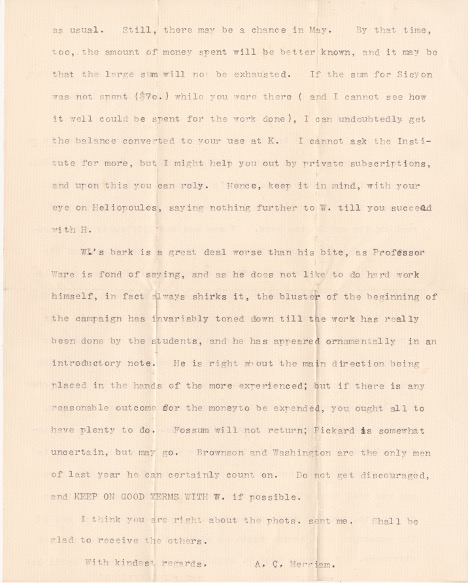
Fig. 2., Second page of a letter from Augustus Merriam to Clarence Young discussing Charles Waldstein, dated January 25, 1892. Columbia University Archives, Rare Book and Manuscript Library
After returning from the ASCSA in the summer of 1892, Young was hired as an instructor of Greek at Columbia. He was granted a full professorship in 1905 and taught at the school until 1937. Throughout his tenure he taught classes about Greek art and made frequent trips to Athens, where he was elected to the managing committee of the ASCSA in 1908.[7] In correspondence dated June 3, 1912, Young asked the President of Columbia whether he might build “a small laboratory collection on the Greek side” for his students’ benefit. The President’s response does not seem to have survived, but Young is still asking for funding to support the establishment of a collection in letters several years later, suggesting that his request was not granted. In sum, based on the evidence preserved in Columbia’s archives, a definite connection between Young and the Argive sherds that carry his name today cannot be established.
If Young didn’t bring the sherds to Columbia, who did? Where did they come from in the first place? Having considered the sherds and their (possibly misleading) namesake, it was time to look beyond Columbia to comparable collections of Argive fragments at other universities. The geographically closest and most similar collection of sherds is held by the Princeton Museum of Art. In April 2019, Curator of Ancient Art Dr. Michael Padgett kindly granted me access to the museum’s study collection of sixty-two Argive sherds. Much like the Columbia collection, each of the most popular Argive motifs is represented at least once at Princeton, making it likely that these sherds were also selected for teaching purposes. A few other surprising connections between the fragments revealed themselves after an examination in person. One sherd in Princeton appears to be by the same artist as a fragment at Columbia.[8] The sherd at Columbia is decorated with marsh birds (Fig. 3). The birds are rather messily painted, but the neatest of them have bodies that resemble hearts turned upside down and dramatically curving necks. The birds on the comparable Princeton piece are rendered the exact same way. The fragments do not appear to share any breaks, and can therefore not be joined, but they did share a craftsman.

Fig. 3., Fragment of a large vessel with rows of birds, Argive Late Geometric II (late eighth century B.C.E.). Art Properties, Avery Architectural and Fine Arts Library, Columbia University, Clarence Young Collection (C00.1736.111a-b). Photographed by Dwight Primiano, Avery Architectural and Fine Arts Library.
The collection at Princeton also proved critical to discovering the Columbia fragments’ provenance. While introducing the Argive fragments, Dr. Padgett relayed that more is known about the origins of the pieces at Columbia than those at Princeton. In the course of cataloging the Princeton sherds in the 1990s, a longtime Columbia Professor, the late Evelyn B. Harrison, had told Dr. Padgett that the Columbia fragments were donated not by Clarence Young, but by James Rignall Wheeler, who in turn obtained them from excavator Charles Waldstein himself.[9] The Columbia fragments were said to have once been accompanied by a note that read ‘C.W.’, thought to refer to Waldstein. Given the strong similarities between the collections at Princeton and Columbia and the similar longevity of their existence in the universities’ collections, they are presumed to have come from the same location, and perhaps the same donor. This significant piece of oral history seemed to finally uncover the source of Columbia’s Argive sherds. Further research proved that the connections revealed by Dr. Padgett are indeed highly likely.
James Rignall Wheeler’s ability and willingness to acquire the fragments has been confirmed by archival research. Wheeler worked at the ASCSA for many years, serving as a member of its managing committee in 1891, the same year that Clarence Young was a fellow there. Wheeler was a Professor at the ASCSA the following year, when Waldstein began excavations at the Argive Heraion. Wheeler even served as chair of the ASCSA from 1901 until his death in 1918. Throughout this entire time, he was also a Professor at Columbia University.[10] Wheeler thus constitutes an obvious link between the ASCSA and Columbia during (and after) the years during which the Heraion was excavated. While his preserved correspondence does not mention the Argive fragments specifically, he does occasionally write to the President of Columbia about the importance of study collections.[11]
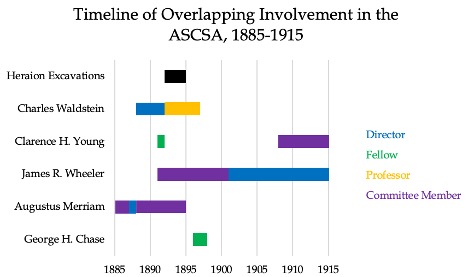
Fig. 4., Timeline of professors’ overlapping involvement in the ASCSA, 1885–1915. The individuals’ roles at the ASCSA are identified with color coding, as noted in the legend.
The ultimate source of the fragments must have been Charles Waldstein, the archaeologist in contact with all of the characters who have so far featured in our story (Fig. 4). Waldstein directed the first excavations at the Heraion from 1892 to 1895. While these excavations were associated with the ASCSA, Waldstein cultivated an idiosyncratic relationship with the School that allowed him, as director of the excavations, to have near total control of the site.[12] In fact, during the first year of excavations at the Heraion, Waldstein was also Director of the ASCSA. It was also during the crucial year of 1892/93 that the likely donor of the Columbia fragments, James Rignall Wheeler, was a visiting professor at the ASCSA. Waldstein may have even had a particular interest in giving material to Wheeler for use at Columbia because of his personal relationship with Columbia University. While Waldstein is largely remembered as a Cambridge scholar, he was born in New York and obtained his B.A. from Columbia College in 1873. In 1884, he accepted an honorary master’s degree from his Alma Mater. In a handwritten letter dated September 30, 1884, he expressed “Of all the honors I have had the good fortune to receive, it is this one which gives me the truest pleasure” (Fig. 5).
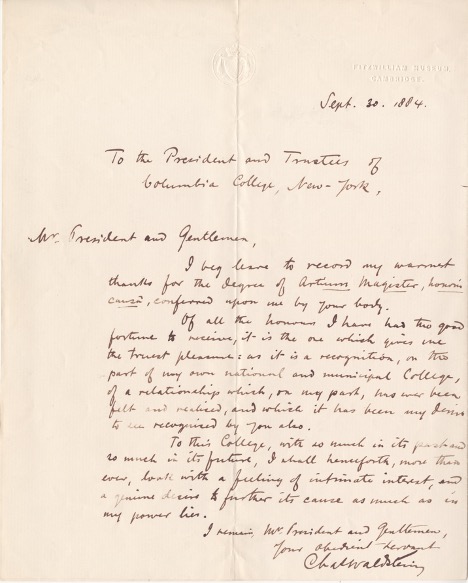
Fig. 5. Letter from Charles Waldstein to the President and Trustees of Columbia College accepting an honorary degree, dated September 30, 1884. Columbia University Archives, Rare Book and Manuscript Library.
Waldstein’s total control of the Heraion excavations, his likely relationship with James Rignall Wheeler, and his association with Columbia all suggest that he would be willing to give some of his finds to the University. His liberality in distributing fragments is further proven by the collection of Argive fragments now in Harvard University’s Fogg Museum. Like the groups of sherds at Columbia and Princeton, these pieces encompass the entire scope of Argive Geometric decoration. At least fifty-three of the Argive pieces at the Fogg are from the Heraion.[13] Remarkably, these pieces were donated by six different individuals.[14] Circumstantial evidence again suggests that most of these donors obtained their pieces from Waldstein. For example, eleven of the Argive pieces now in the Fogg were originally loaned to the Harvard Classics Department by Professor George Henry Chase, who was a fellow at the ASCSA from 1896 to 1898, just after Waldstein completed excavations at the Heraion. Chase even assisted Waldstein in the publication of the Heraion’s finds.[15] The details of Chase’s donation of sherds to Harvard are lost, but his proximity to Waldstein is undeniable.
The large number of individuals who were once in possession of fragments from the Argive Heraion and the great quantity of fragments from the site now in the collections of Harvard and Princeton help prove that Columbia’s collection originated in the same place. They also show that Waldstein was generous with his finds, something that has not been explored in previous discussions of the archaeologist or the universities’ ceramics. One reason for the lack of attention to these Argive collections could be the questionable legal circumstances of their initial distribution. The sale and transfer of Greek antiquities outside Greece was first outlawed in 1827, beginning a long line of legislation protecting Greece’s cultural heritage.[16] In 1834, Greece began to grant export licenses for objects that could be classified as “duplicates,” “insignificant,” or “surplus.”[17] This law remained the primary defense against exportation until 1899. From 1834 to 1899, then, it is possible that Waldstein obtained an export permit for the fragments based on their perceived “insignificance.” Regardless of the lawfulness of Waldstein’s initial exports, the Argive collections discussed so far are exempt from claims for repatriation because they were all in the possession of American universities before the UNESCO 1970 Convention on the Means of Prohibiting and Preventing the Illicit Import, Export, and Transfer of Ownership of Cultural Property was ratified.
The search for the origins of the Argive fragments at Columbia revealed much more than was initially expected. This small group of sherds were not originally part of a collection established by Clarence H. Young, and likely became associated with his name only by chance. While we may never know how they were absorbed into the Young Collection, we can hypothesize that Young used them to teach, or that they were stored in Young’s office when he retired and were transferred to Art Properties from there. Instead, these fragments are part of a large group of sherds distributed by Charles Waldstein during or shortly after his excavations at the Argive Heraion at the end of the nineteenth century. They were chosen with the intention of representing the entire scope of Argive Geometric pottery, making them effective tools for training field archaeologists. The existence of comparable collections at Columbia, Harvard, and Princeton suggests that Waldstein was giving his sherds out widely to colleagues he met at the ASCSA. The group of professors who acquired and taught with these fragments were connected socially and professionally in a network centered on the ASCSA. While the present study has only identified fragments from the Heraion in three universities, it is highly likely that more exist in private and public collections throughout the United States. The investigation into Columbia’s twenty sherds has demonstrated the importance of oral history and of reconstructing social connections between excavators and donors to provenance research. Though small, this group of sherds and the search for its origins may help other researchers uncover the heritage of early study collections.
Due to stricter regulations protecting cultural heritage, it is more difficult for American universities to establish study collections today than it was during Waldstein’s time. The constriction of antiquities exports amplifies the importance of the fragments already owned by schools. Along with the other fragments in the Young Collection, the Argive sherds are an excellent resource for teaching graduate students. They also have immense potential for use in undergraduate classrooms. Models for seminars studying under-researched archaeological collections are plentiful.[18] The artifacts could be studied in classes about the methodology of archaeological stewardship,[19] or they could become the basis of a theoretical course exploring the social lives of objects.[20] They are a compelling case study through which the history of Columbia or of early excavations in Greece might be explored. The entire Young Collection is also relevant to classes about Greek pottery, trade in the ancient Mediterranean, artistic method and production in antiquity, and more. Now that the Parallel Heritages project has returned attention to these fragments, they might again be used in the classroom as their donor intended, serving a renewed purpose millennia after they were made.
Monica Bulger is a PhD candidate in the Department of Art History and Archaeology at Columbia University. Her dissertation explores uses of frontality in Archaic Greek art.
References
[1] I would like to thank Professors Holger Klein and Alain Duplouy for starting this initiative, and Dr. Roberto Ferrari and Lillian Vargas for shepherding my work in Art Properties.
[2] In the early 2000s, Professor Joanna Smith led a seminar to introduce students to the fragments and worked to preserve them. Dr. Senta German studied the origins of the Bronze Age fragments in the collection in 2016. Over the last several years, Columbia PhD candidate Joseph Woldman has developed a catalog of the collection to facilitate its digitization. For more on German’s work, see Paul Hond, “Great Excavations,” Columbia Magazine, Fall 2018, 9–10.
[3] Laura Jean Siegel, “An Argive Dancer at Columbia University,” American Journal of Archaeology 81.3 (1977): 363–365.
[4] One fragment identified by Siegel as Argive (Columbia University Inv. No. C00.1736.114) is probably Euboean.
[5] J. N. Coldstream, “Argive Geometric,” in Greek Geometric Pottery: A survey of ten local styles and their chronology (Exeter, 1968), 112–148.
[6] Young eventually wrote the obituary of his mentor. See Clarence H. Young: “Necrology: Augustus Chapman Merriam,” The American Journal of Archaeology and of the History of the Fine Arts 10.2 (1895): 227–229.
[7] For more information on Young’s career, see William B. Dinsmoor, “Clarence Hoffman Young 1866–1957,” American School of Classical Studies at Athens. Seventy-sixth Annual Report 1956–1957 (Princeton, 1857): 16–17.
[8] The piece in the Princeton Museum of Art is Inv. No. 1999–119. A catalogue of Princeton’s Argive fragments written by Nassos Papalexandrou notes that the birds on the Princeton fragment are likely rendered upside down, which is unusual. It is difficult to determine whether the same is true of the birds on the Columbia fragment.
[9] Harrison later moved to Princeton University and concluded her career at New York University’s Institute of Fine Arts. Though she did not know Wheeler personally, Harrison obtained all of her degrees at Columbia and taught in its Department of Art History and Archaeology for 15 years, suggesting that she was well acquainted with its collections. Moreover, she began working at the Athenian Agora in 1949 and continued to work with the ASCSA for the rest of her career and may have known more about its early excavations.
[10] Louis E. Lord, “The Chairmanship of James Rignall Wheeler,” in A History of the American School of Classical Studies at Athens: 1882–1942 (Cambridge, 1947), 99–130.
[11] On December 18, 1904, Wheeler wrote to Columbia University President Nicholas Butler that the collaboration between the Museum of Fine Arts in Boston and educational institutions in Boston and Cambridge was admirable and expressed interest in establishing a collection of his own at Columbia.
[12] “Waldstein’s friends on the Commmitee [of the ASCSA] succeeded at the November meeting in 1893 in passing a vote again limiting the director’s authority by giving entire charge of the Argive Heraeum excavation to Waldstein […].” Lord, A History of the American School, 56.
[13] I am grateful to Megan Schwenke for facilitating my visit to the Harvard Art Museum Archives, where much of this information was uncovered.
[14] These donors are George Henry Chase, Bettina J. Kahnweiler, Professor C. E. Norton and Richard Norton, George H. Browne, Mary H. Buckingham, and the Pfeiffer-Hartwell Collection.
[15] George Henry Chase and Charles Waldstein, “The terra-cotta figurines,” in The Argive Heraeum Volume 2 (Boston, 1905).
[16] This first law was passed at the Third National Assembly of Troezen. Daphne Voudouri, “Greek legislation concerning the international movement of antiquities and its ideological and political dimensions,” in A Singular Antiquity: Archaeology and Hellenic Identity in Twentieth-Century Greece, ed. Dimitris Damaskos and Dimitris Plantzos (Athens, 2008), 125.
[17] Voudori, 126.
[18] For examples, see Joanna S. Smith, “Bringing Old Excavations to Life,” Near Eastern Archaeology 71.1/2 (2008): 30–40; and Barbara L. Voss, “Curation as research: a case study in orphaned and underreported archaeological collections,” Archaeological Dialogues 19.2 (2012): 145–169.
[19] Informal studies suggest that only 18% of universities with programs in anthropology or archaeology offer training in collections stewardship. Nicolette B. Meister, “A Guide to the Preventive Care of Archaeological Collections,” Advances in Archaeological Practice 7.3 (2019), 268. For the argument that the stewardship of archaeological collections is an ethical issue, see S. Terry Childs, “Archaeological Collections Management in the United States: Developing a Path to Sustainability,” in Caring for Our Collections, Papers from the Symposium: Developing Sustainable, Strategic Collections Management Approaches for Archaeological Assemblages, ed. Charlotte H. F. Smith and T. Murray (Melbourne, 2011), 21–22, 29–30.
[20] Osborne has argued that small collections in university museums are especially useful for relatively conceptual research of this nature. Robin Osborne, “De-contextualising and Re-contextualising: Why Mediterranean Archaeology Needs to Get out of the Trench and Back into the Museum,” Journal of Mediterranean Archaeology 28.2 (2015): 242–243.
Published on May 11, 2021.

